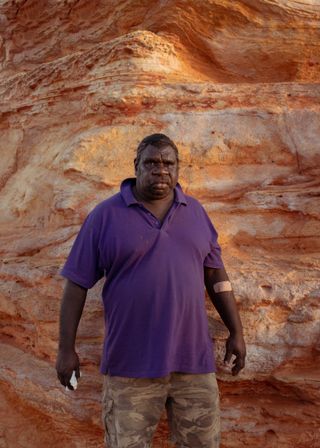If The River Dies
2021

The Nyikina people have lived in symbiosis with the Mardoowarra (Fitzroy) River for more than 60,000 years. The River is the lifeblood of the Kimberley region of Western Australia, and it is threatened by extensive development proposals from the agriculture and mining industries within the catchment area.
Nyikina Elder Linda Nardea, and her son Kimberley Watson speak of how their people read Country like a book, and since colonisation they’ve witnessed extractive industries slowly rewrite the ancient stories of their land and waters. These stories have been shared through Country by all native species, fish and flowers, animals and plants, living beings that are now sick.
This sickness is felt by the Nyikina people, who refer to health and wellbeing as Marboo- joonoo Liyan. They understand that their Marboo-joonoo Liyan is intrinsically connected to Country - they have lived with this interconnected ecosystem since time immemorial - and the Nyikina witness how symptoms expressed through Country are connected to their own body, and how diseases we feel are also felt by Country.
Linda says if “the land die, we die, the river die, we die. When we see those sorts of things happen, we get sick. The sickness shows in our body, because we see bad things happen to our land.”
Kimberley says “you look after Country, Country look after you”, and with the ongoing climate crisis, the Nyikina way of being inspires us to question how we relate with our ecosystem: are we willing to change how we treat Country, or will we continue treating the symptoms of our consumptive behaviour? Whether we look at it through the Nyikina or the Western lens, if we don’t make that change soon, Country dies and so do we.
Linda stands by a floodplain in the Mardoowarra catchment where she used to go as a child with her family. “See all those trees there, that used to be our dinner camp. Dad, Mum and all the old people used to bring us here as little kids. All them trees there, that’s where our dinner camp was. Now you can’t see, it’s where we used to pick up the ngarbijarra [bush cucumber] all along, it’s underwater now.”
According to the Bureau of Meteorology, there are parts of northern Australia where annual rainfall and streamflow have increased 100 mm on average since the 1970s. As the climate warms, heavy rainfall events are expected to become more intense, because a warmer atmosphere can hold more water vapour. This could explain why areas Nyikina people used to be able to access are now underwater.
Annie Milgin, a Nyikina Elder and Linda’s older sister, talks about the declining accessibility of bush tucker (traditional foods) that she has seen on Country over the last 10 years. “When we go out on Country, we know there’s food there to provide for us and some are no longer there. We not finding the Koongarra [gooseberry tree] anymore. The Doctors say you gotta have your healthy mangarri [food].” As a result, more and more of the Nyikina people are getting sick. “Those foods provided iron and vitamins.”